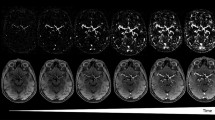Abstract
We sought to compare a three-dimensional, contrast-enhanced, magnetic resonance angiogram (3D CE MRA) sequence combining parallel-imaging (generalised autocalibrating partially parallel acquisitions (GRAPPA)) with a time-resolved echo-shared angiographic technique (TREAT) in an intraindividual comparison to a standard 3D MRA sequence. Four healthy volunteers (27–32 years), and 11 patients (11–82 years) with vascular pathologies of the hand were examined on a 1.5-Tesla (T) MR system (Magnetom Avanto, Siemens, Erlangen, Germany) using two multichannel receiver coils. Following automatic injection (flow rate 2.5 cc/s) of 0.1 mmol/kg gadoterate (Dotarem, Guerbet, Roissy, France), 32 consecutive 3D data sets were collected with the TREAT sequence (TR/TE: 4.02/1.31 ms, FA: 10°, GRAPPA acceleration factor: R=2, TREAT factor: 5, voxel size: 1.0×0.7×1.3 mm3) and a T1-wwighted 3D gradient-echo sequence (TR/TE: 5.3/1.57 ms, FA: 30°, GRAPPA acceleration factor: 2, voxel size: 0.71×0.71×0.71 mm3,). MR data sets were evaluated and compared for image quality and visualisation of vascular details. In the volunteer group, all MR imaging was successful while technical problems prevented acquisition of the standard protocol in two patients. For the corresponding segments, the number of visible segments was equal on both sequences. Overall image quality was significantly better on the standard protocol than on the TREAT protocol. TREAT MRA provided functional information in lesions with rapid blood flow, e.g. detection of feeding and draining vessels in an haemangioma. TREAT-MRA is a robust technique that combines morphological and functional information of the hand vasculature and deals with the very special physiological demands of vascular lesions, such as quick arteriovenous transit time.




Similar content being viewed by others
References
Connell DA et al (2002) Contrast-enhanced MR angiography of the hand. Radiographics 22(3):583–599
Rofsky NM (1995) MR angiography of the hand and wrist. Magn Reson Imaging Clin N Am 3(2):345–359
Goldfarb JW et al (2001) Contrast-enhanced MR angiography and perfusion imaging of the hand. AJR Am J Roentgenol 177(5):1177–1182
Sodickson DK, Manning WJ (1997) Simultaneous acquisition of spatial harmonics (SMASH): fast imaging with radiofrequency coil arrays. Magn Reson Med 38(4):591–603
Pruessmann KP et al (1999) SENSE: sensitivity encoding for fast MRI. Magn Reson Med 42(5):952–962
Griswold MA et al (2002) Generalized autocalibrating partially parallel acquisitions (GRAPPA). Magn Reson Med 47(6):1202–1210
Bilecen D et al (2004) Optimized assessment of hand vascularization on contrast-enhanced MR angiography with a subsystolic continuous compression technique. AJR Am J Roentgenol 182(1):180–182
Cashen TA, Kroeker R, Leloudas N, Carr JC, Hopkins JK, Carroll TJ (2005) Comparison of temporal and spatial undersampling techniques for time-resolved contrast-enhanced MR angiography. ISMRM
Krause U et al (2002) High resolution contrast enhanced MR-angiography of the hand arteries: preliminary experiences. Vasa 31(3):179–184
Winterer JT et al (2000) Optimization of contrast-enhanced MR angiography of the hands with a timing bolus and elliptically reordered 3D pulse sequence. J Comput Assist Tomogr 24(6):903–908
Fink C et al (2005) Time-resolved contrast-enhanced three-dimensional magnetic resonance angiography of the chest: combination of parallel imaging with view sharing (TREAT). Invest Radiol 40(1):40–48
Lee VS, Lee HM, Rofsky NM (1998) Magnetic resonance angiography of the hand. A review. Invest Radiol 33(9):687–698
Pinto CM, Carroll TJ, Omary RA, Sato K, Kroeker R, Simonetti O, Carr JC (2005) Time-resolved magnetic resonance fistulography with TREAT and GRAPPA for surveillance of hemodialysis arteriovenous fistulae. Proc Intl Soc Magn Res Med 413
Author information
Authors and Affiliations
Corresponding author
Rights and permissions
About this article
Cite this article
Brauck, K., Maderwald, S., Vogt, F.M. et al. Time-resolved contrast-enhanced magnetic resonance angiography of the hand with parallel imaging and view sharing: initial experience. Eur Radiol 17, 183–192 (2007). https://doi.org/10.1007/s00330-006-0275-5
Received:
Revised:
Accepted:
Published:
Issue Date:
DOI: https://doi.org/10.1007/s00330-006-0275-5




